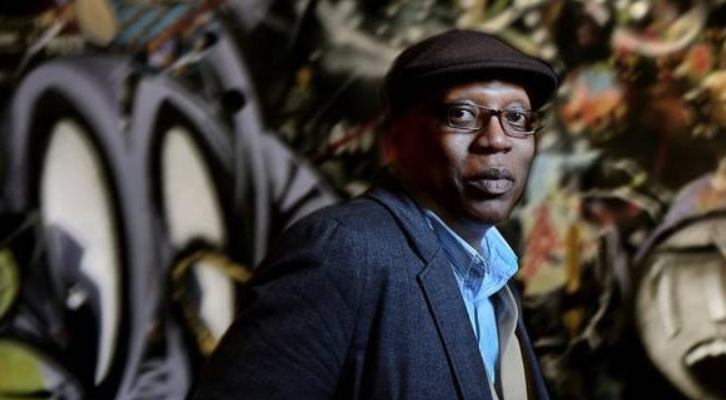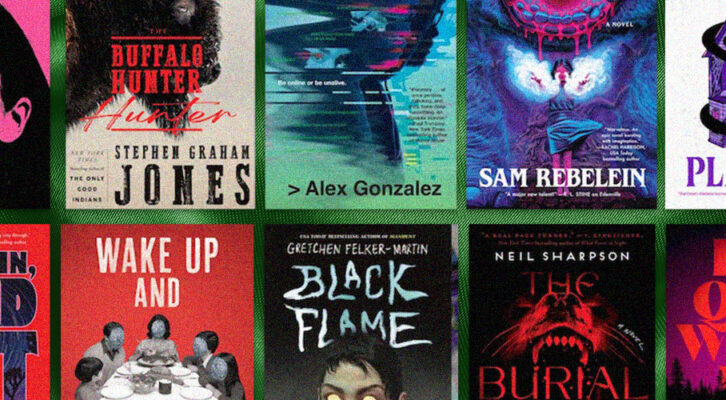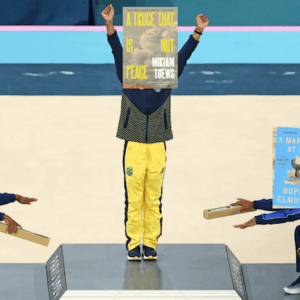
Glenn North on Kansas City’s Jazz, Poetry, and Barbeque
In Conversation with Whitney Terrell and V.V. Ganeshananthan on Fiction/Non/Fiction
With AWP’s annual conference headed to Kansas City next week, poet and activist Glenn North joins co-hosts Whitney Terrell and V.V. Ganeshananthan to tell incoming writers where to find the best food and coolest hangouts in the city. North discusses Kansas City’s diversity, its history of racial covenants, and its newly rejuvenated Crossroads Arts District, which is near the convention site. North and Terrell, who also lives in Kansas City, highlight a variety of spots to check out, including the Green Lady Lounge, Swordfish Tom’s, The Blue Room, the American Jazz Museum, and Kansas City’s not-to-miss barbeque scene. North reads his poem, “Harmony on the Vine,” about the 18th & Vine Historic Jazz District, where he is the current poet laureate, as well as an excerpt from his poem for the 25th anniversary of the American Jazz Museum.
Check out video excerpts from our interviews at Lit Hub’s Virtual Book Channel, Fiction/Non/Fiction’s YouTube Channel, and our website. This episode of the podcast was produced by Anne Kniggendorf.
*
From the episode:
V.V. Ganeshananthan: Glenn, you’ve written a lot about Kansas City’s relationship with jazz, and you were the Poet Laureate of the Historic 18th & Vine Jazz District. Could you read us a poem about that and then talk to us about the city’s relationship with jazz?
Glenn North: Sure. So the poem I was thinking I would share is called “Harmony on the Vine” and it was inspired by this art project that was happening on Vine one summer. There was a pop up mural that was being painted and people from all ethnicities, all ages, were contributing to the production – or the creation, I should say – of this mural. And so this poem was called “Harmony on the Vine.”
In these times of such upheaval
when the only choice
for Commander-in-Chief
is the lesser of two evils,
when men of color in
their various hues
are human targets
for the boys in blue
when a Dakota Pipeline
matters more
than the indigenous people
who were there before,
when immigrant families
are torn apart
and children are ripped
from their mother’s arms
when voter suppression
in the southern sphere
turns the clock back fifty years
when little girls in Flint
can’t brush their teeth
‘cause the water is filled
with toxic debris
It’s time to step back
and examine our hearts
It’s time for life
to imitate art…
This miraculous mural
has taught us this much
we can learn to spill paint
not blood.
Each delicate brushstroke,
each scene depicted
shows that despite
our various pigments
we are truly just one race –
one human family
in various shades.
No matter how divisive
they may try to paint us,
somewhere deep inside
we know that that ain’t us.
Even when we reflect
on this town’s history,
and look under the sheets
to a time when black folks couldn’t live
past 27th Street,
we know even then
there was a place
where jazz music transcended
the notion of race.
where no one cared
if you were white or Black
if you were movin’ and groovin’
to the 12th Street Rag,
where musicians at Milton’s
didn’t discriminate,
all they cared about
was if you could play.
Where Hootie and Bird’s
genius left stereotypes shattered,
showing the world
that Black Music Matters!
Yes, there was a majesty,
a splendor,
going far beyond wealth,
that occupied the space
between 18th and 12th.
If you take time
to notice that glory isn’t gone,
at the American Jazz Museum
the tradition jams on.
Just think of it all
the beautiful hands that took part
in creating this incredible
work of art.
This masterpiece is an alarm,
a wake-up call, a cry…
a siren screaming to all
stop believing the lie,
the road is too long
the stakes are too high
so we must paint the way
and help the world find
the harmony we created
here on the vine.
Whitney Terrell: Thank you very much. In the poem you reference Hootie and Bird. And I wonder if you could talk a little bit about who these musicians are and give us some background on Kansas City’s jazz history. You already talked about 18th and Vine, but you know, where should people go see jazz today?
GN: So Hootie was the nickname for Jay McShann, and Jay McShann was a great piano player, actually from Oklahoma, but there were a lot of territory bands that were moving around in the early 1900s. We use that term, the Chitlin Circuit, there was also the Southwest Circuit, so a lot of bands were traveling from Oklahoma, Texas, Arkansas, Missouri, and there was kind of a circuit that was already developing. So as I said, when prohibition went into effect in the 20s, Kansas City had all the great jazz clubs, so a lot of the musicians just moved to Kansas City, and that was the case with Jay McShann, and he’s credited with discovering Charlie Parker, and also giving Charlie Parker his nickname. There are a couple of different stories, but back in the day, a lot of people raised chickens in their yard and the slang term for chicken was yard bird. Charlie Parker loved chicken and so Jay McShann and the band started calling him Yardbird. Like Bird, for short.
So, yeah, but in terms of what’s happening on the scene now, I mentioned the Blue Room. In the Crossroads District, there’s a Corvinos Jazz Club, which is really popular, also, the Green Lady Lounge. They have jazz all hours of the night, on the weekends. If people really want to be in the heart of where the Kansas City jazz scene is really anchored, it’s at Mutual Musicians’ Foundation, which is 19th and Highland but it’s still in that general 18th and Vine jazz district. In 1919, the Black musicians started a union because they weren’t making as much as their white counterparts, oftentimes working even longer hours, and so it was really kind of a revolutionary thing. So after musicians would play whatever gigs they had, they would go to the Foundation and play ‘till the sun came up. That tradition is still kept alive at the Foundation on Friday and Saturday night.
The Jam Session doesn’t start until one o’clock in the morning, and so it goes until 5:30. It’s still a cool place to hang out, and that’s where the musicians really, you know, get a chance to explore. There might be one musician that’s hosting the jam session, but musicians from all over the city kind of congregate here and take turns. This is really a good time – if you can handle it. I can’t go like I used to. If I go to the foundation now it takes me about three months to recover.
WT: It is an amazing place if you get a chance to go.
V.V.G: It’s a dangerous thing to ask the 15,000 regular attendees of AWP if they can handle it . . . There are Kansas City neighborhoods beyond downtown. For those who are interested in going a little bit farther afield, what is the Country Club Plaza? Brookside? I believe there’s an Overland Park?
GN: Maybe I should let Whit answer..
WT: Go for it, man! One thing before you start, Green Lady Lounge is also in the Crossroads on Grand and it’s a two level jazz club that I think is quite good.
GN: Yeah. I was just gonna say the Country Club Plaza was one of the first outdoor shopping centers, it’s a huge Kansas City landmark. Not terribly far from the downtown area and it has a lot of great shops, a lot of great restaurants. The architecture was modeled after Seville, Spain. So it’s got this really unique architecture and people who visit Kansas City find that to be one of the most iconic areas in Kansas City to visit. Brookside is a neighborhood that also has some unique shops and kind of boutique shops and some cool restaurants. What are some of the places that you like to eat there, Whitney, do they have any local restaurants that you like there?
WT: I mean, the Plaza is on 47th Street. Okay, so your hotel is going to be on 12th Street, where the Marriott is, right? So you’re going to have to Uber if you want to go to the Plaza or Brookside. But the coolest view of the city right now is a place called Prime Social that’s on the Plaza. You have to make reservations to go up there, but it’s a rooftop bar that has an amazing view out over the Plaza and Brush Creek, and is very chic. If you are looking for high-end drinks in a cool spot that you want to pay a lot of money for, that’s where you should go. And if you want a restaurant that is right in my neighborhood, literally blocks from my house on 59th Street, you could go to Earl’s Premiere, which is a really fantastic seafood and oyster-based restaurant. It’s a little neighborhood restaurant that people love. It’s very hard to get into, so I would make a reservation. Those would be my suggestions. And Overland Park is too far away for me to know anything about. It’s far south. It’s way out in Kansas. It’s the suburbs. Glenn and I don’t go there. We don’t advise you to go there.
GN: It’s not safe! No, I’m kidding. But yeah, if you’re in Kansas City, unless you have relatives, I mean, it’s a suburb. There’s some restaurants, you know, out there too. But that’s kind of a long ways away. But generally it’s interesting that Kansas City is very spread out and Overland Park is kind of considered to be one of the suburbs of Kansas City, even though it’s in Kansas, I know that this confused people.
WT: You could drive 40 minutes in your car in one direction on a highway and still be in the city. It’s quite large. Which brings us to a topic that Glenn and I have talked about a lot, and that is race and class in Kansas City. I don’t think you can really understand where you are in Kansas City without understanding that. So here comes a very familiar topic to Kansas Citians, one that’s probably not familiar to outsiders. Troost Avenue, the east side, the west side, St. John’s Avenue, Columbus Park. Glenn, could you talk a little bit about Kansas City’s diversity and also its division?
GN: Yes. So that’s a pretty heavy discussion. But we were talking about the Plaza. And the Plaza was developed by this developer who was very successful, his name was J.C. Nichols. And he was really complicated in that he did a lot of things for Kansas City. But he’s also known for his mastery of redlining, and creating this flight from the city into the suburbs. He actually created a lot of suburbs around the Greater Kansas City area that still exist.
Transcribed by Otter.ai. Condensed and edited by Madelyn Valento. Photo courtesy of the author.
*
City of Song • Check Cashing Day • Love, Loss, and Violence: A Visual Dialogue on War
Others:
American Jazz Museum • Nelson-Atkins Museum of Art • Kansas City Museum • The Arabia Steamboat Museum • World War I Museum • Union Station • Kansas City Public Library • BLK + BRWN • Bliss Books & Wine • Rainy Day Books • Wise Blood Booksellers • Writer’s Place • Green Lady Lounge • Afterword • The Mutual Musicians Foundation • 21c • Corvino • Farina • Extra Virgin • Anton’s • Soriée • Lulu’s • Jarocho • Prime Social • Earl’s Premier • River Market • Country Club Plaza • Gates Bar-B-Q • Jack Stack Barbeque • Bryant’s Barbeque • Joe’s Kansas City Bar-B-Que • Q39 • LC’s Bar-B-Q
Fiction Non Fiction
Hosted by Whitney Terrell and V.V. Ganeshananthan, Fiction/Non/Fiction interprets current events through the lens of literature, and features conversations with writers of all stripes, from novelists and poets to journalists and essayists.



















